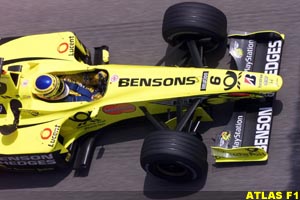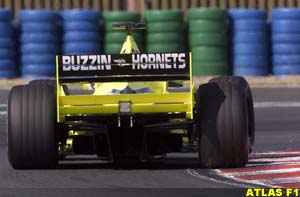| ATLAS F1 Volume 6, Issue 34 | |||
 |
The F1 Rulebook | ||
| by Will Gray, England | |||
|
In a series of articles, Will Gray delves into Formula One's rulebook and investigates the in-depth documentation that governs Formula One: from rules defining how the event should be run, to those restricting designers and engineers in technical areas
Part 6: Defining Dimensions
It is no coincidence that the Formula One car is the shape and weight it is - that is very much defined by the championship's governing body. Through the tight defining ruleboxes in 'Article 3' of the FIA regulations, the size of bodywork is restricted, and the Formula One template is formed.
The first defining rule is that the overall weight of the car (including suited and booted driver) must not be less than 600kg, but ballast is allowed to get the car to this figure to bring it up to this weight. This is one of the most important rules in F1, because the lower the basic car can weigh, the more ballast the teams can use to position weight in the best areas of the car. No extra weight, however, can be added during a race because teams may add it right at the end to make an underweight car legal.
Firstly, the height of the car must be no greater than 95cm. This is an important rule, because although teams are always looking to lower the car's centre of gravity, certain areas (such as the rear wing, and the nacelle above the driver's head) work better in cleaner air, so teams want these to be higher up and out of the way of the rest of the bodywork. However, the rear wing comes under further restrictions because another rule ensures that all bodywork more than 15cm behind the rear wheels must be below 80cm.
The overall width of the car must be less than 1.8 metres, although no bodywork ahead of the rear wheels can be more than 1.4 metres wide. Because the track (which is basically the width), and the length of a car are virtually coupled by a textbook ratio which should give the best handling, this width rule will also, to a point, define the car's length. Of course, however, it's not quite as simple as that, and the maximum width figure only gives the designer a ballpark figure for the car's length which is then up to the team to decide.
Back in 1997, the overall width of the cars was 20cm greater, and when the figure was reduced for the start of 1998, many teams got their modifications wrong. McLaren got their wheelbase right that year, so they shot to form and took the title.
The only rules regarding length are for the overhangs on the car - the parts ahead of the front wheels, or behind the rear wheels. At the rear, the overhang must be no more than half a metre, while at the front, bodywork is permitted up to 1.2 metres ahead of the front wheels. This rule has the condition that there is to be no bodywork further than 20cm out from either side of the car centre line at any point that is more than 90cm ahead of the front wheels - this restricts some of the bargeboard work that the teams may have otherwise considered.
Although the front wing is allowed to reach the extremities of the overall width, most teams do not use it all, because they have found a better way to use their maximum dimensions. The flick-ups and steps seen on the front wing endplates take up some of the allowed width, and although some downforce is lost by a reduction in wing area, teams have found that the endplates make the front wing work harder, and can actually increase the downforce overall.
However, ahead of a point which is 33cm rearward of the front wheels (somewhere around the mid front chassis area), a rule states that any bodywork, if it is further than 25cm from the car centre line, must be between 5cm and 25cm from the reference plane. This dictates the height and overall dimensions of the front wing and its endplates, but an additional rule states that the leading edges of any piece of bodywork ahead of the front wheels must be at least 1cm thick, and have a significant radius - this is to prevent tyre damage in the event of a collision, and stops 'wacky racers'-style razor blade racing from entering Formula One!
Finally, there is a rule box which basically sits just behind the front wing and in front of the sidepods, and covers the area from 40cm to 90cm from the car's centreline. No bodywork other than brake cooling ducts is allowed in this area, and this further restricts bargeboard design, and prevents cars sprouting any wings in this region.
Other than that, the main restrictions are ahead of the rear wing, and are there to minimise use of winglets and long rear wing end fences. Any bodywork more than half a metre from the car centre line (which is the same measurement as the maximum rear wing width either side) must be lower than 50cm if it is anywhere less than 80cm forward of the rear wheels, and must be lower than 30cm if it is anywhere less than 40cm forward. Furthermore, between 33cm forward, and 15cm rearward of the rear wheels, no bodywork can be more than 60cm high. All these figures define a pretty narrow development area for the front and rear wings, and for the car as a whole - yet the teams still manage to go faster and faster!
Previous Parts in this Series: Part 1 | Part 2 | Part 3 | Part 4 | Part 5
|
| Will Gray | © 2000 Kaizar.Com, Incorporated. |
| Send comments to: gray@atlasf1.com | Terms & Conditions |


